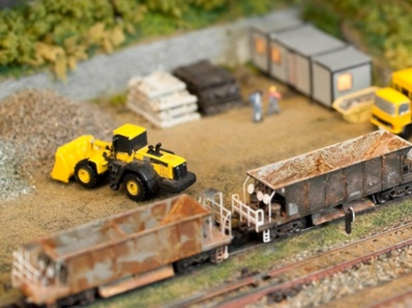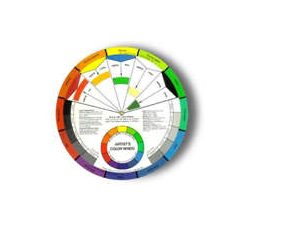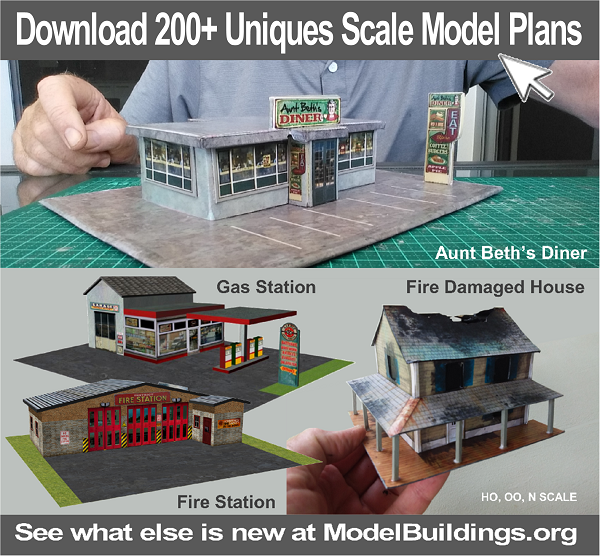Techniques For Using Colors, Textures, Weathering and Adhesives on Model Railroads
Colors and textures are key parts of your layout. Realism is about simulating the colors and textures of the things surrounding you in the real world.
Mixing and Selecting Colors For Your Railroad Scenery
If you are not good at mixing colors, you can purchase a Color Wheel (from an art shop or from Amazon) to help guide you with tints, hues, tones and color relationships. Whenever possible, use acrylic paint colors. Acrylic paints are water based and can be readily thinned to a consistency that will be easy to work with.
An added bonus is that brushes and airbrushes are easier to clean by using plain water, as opposed to mineral turpentine or other solvents.
Add color to different textures in different patterns or arrangements. This looks authentic and makes it feel as though it has been through plenty of real-world weathering.
In addition, colors should be used with natural appearance in mind. You should focus on greens, grays, and browns for the most part, although white can be used in winter scenes. White is also one of several colors to use for mixing lighter shades. © Copyright http://www.modelbuildings.org All rights reserved.
Textures Can Give Railroad Scenery A Natural Look
Scenery textures give the railroad setting a natural look. When first creating a layout, it is common to lay the track on a flat board or bench to give the trains a smooth and even surface on which to operate. Keeping the track as level and even as possible will keep derailments and maintenance issues to a minimum. Real railroads do this when creating a right of way and you should too.
However, for parts of the layout not directly under the track choose to go a little uneven for a more natural look. This can include creating small hills around the surface. Be sure that the changes from one elevation to the next are gradual unless you particularly want a cliff face. Mountain features may also be added. The best part of putting a mountain on the layout is that it does nothave to be absolutely perfect. You can simply add a few jagged cliffs or edges to your mountain as you see fit.
Weathering Model Trains and Buildings
Closely related to colors and textures is the broad subject of weathering. If you buy a shiny new car and drive it around for a few weeks in a part of the country that gets any amount of precipitation, it will begin to get dirty. In other words, it is weathered. Anything left outside in the elements will become weathered after a short time, and the new shine and colors will become faded and dulled. As an automobile or homeowner, you can certainly spend a weekend washing your car or house, or applying a new coat of paint when needed.
The rest of the world is definitely not so well maintained! Buildings not only fade, but fall into disrepair, neglect and outright dilapidation. If you place a bunch of shiny new rolling stock and newlooking structures on your layout, you’ll never escape the toy like appearance of the miniatures.
You’ll notice the scale models building plans for sale on this site have incredibly realistic weathering details already included, so painting and airbrushing is not necessary, unless you just want to touch up some of the edges after construction is complete. Matt Mod Podge or clear spray matt varnish can be used
as a sealant following construction. The photo-realist features on the plans include cracks in brickwork, water stains, mold stains on buildings etc. A free catalog is available for download from the HOME PAGE.
As a modeler, realism is (or should be) sacrosanct, so you’ll need to be prepared to make that new locomotive or caboose positively grimy to get the right effect. Almost nothing outside in the real world is clean, and that is the philosophy you want to keep in mind for your layout as well. Railroads are notoriously cheap, so they seldom spend money sprucing up the rolling stock and motive power, or their structures either! There is probably no other technique that can enhance realism so effectively, and is so unbelievably easy to do.
Note the weathered condition of these wagons.

Different objects weather in different ways, so there’s a lot of opportunity for trying something out and changing it if the look isn’t quite right. With chalks, in particular, it’s very easy to just wipe or wash the model down and start over if you don’t like what you’ve done. As always, testing your technique on a discarded model of some kind or just a piece of scrap plastic or wood is a great way to get the look you are seeking.
The first rule of technique is, “No bright colors”. Rule number two is, “Glossy is bad”.


